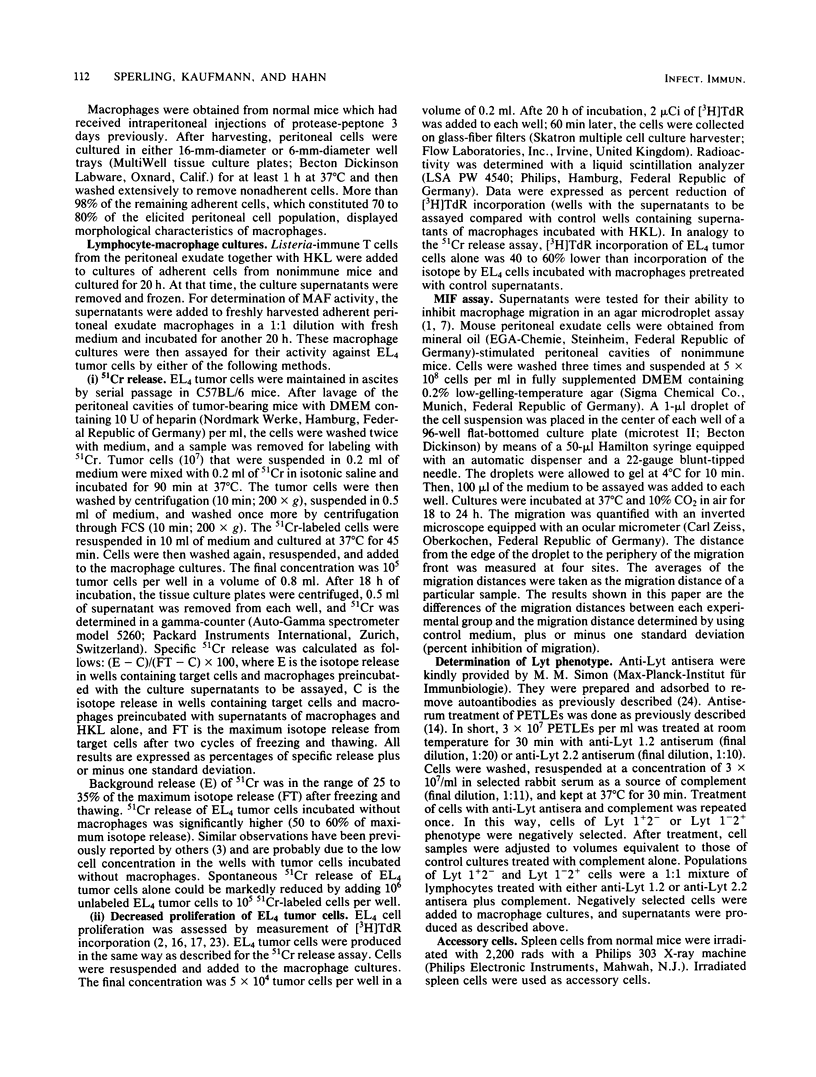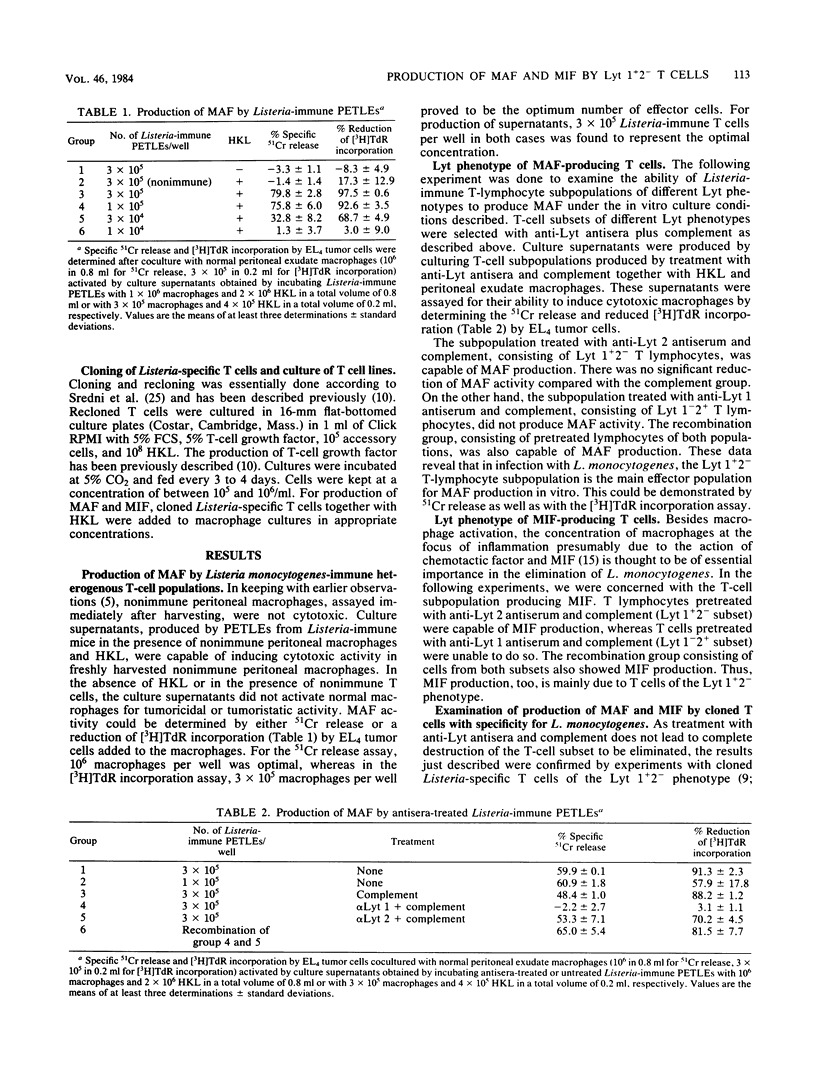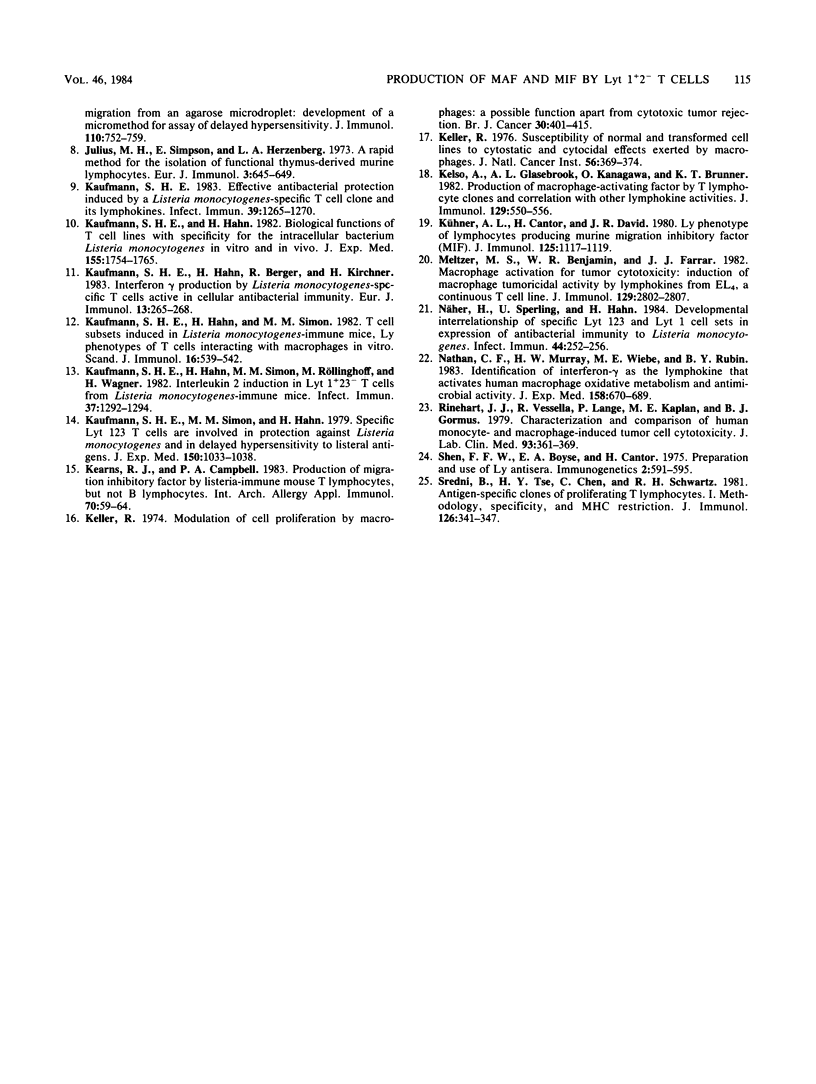Abstract
Lyt-selected Listeria-immune T lymphocytes from peritoneal exudates and cloned T cells were cocultured with heat-killed listeriae and peritoneal macrophages from nonimmune donors. Supernatants were assayed for: activation of macrophages for tumoristatic and tumoricidal activity via macrophage-activating factors and migration-inhibition factor activity. Peptone-induced peritoneal macrophages were activated by incubation with the supernatants for 24 h. For examination of cytocidal activity, 51Cr-labeled EL4 tumor cells were subsequently added, and 51Cr release was determined. Cytostatic activity was measured by adding unlabeled EL4 tumor cells to the pretreated macrophages and determining [3H]thymidine incorporation 24 h later. Migration-inhibition factor production was examined in an agar microdroplet assay. Only Listeria-specific T cells of the phenotype Lyt 1+2- proved active in these assays, whereas T cells of the phenotype Lyt 1-2+ were not active. When T-cell clones were used, a single clone was capable of inducing macrophage-activating and migration-inhibition factor production at cell concentrations of ca. 10(3)/ml.
Full text
PDF




Selected References
These references are in PubMed. This may not be the complete list of references from this article.
- Adelman N., Hasson M., Masih N., Cohen M. C. Correlation between agarose microdroplet and capillary tube procedures as assays for migration inhibition of target cells. J Immunol Methods. 1980;34(3):235–242. doi: 10.1016/0022-1759(80)90050-2. [DOI] [PubMed] [Google Scholar]
- Calderon J., Williams R. T., Unanue E. R. An inhibitor of cell proliferation released by cultures of macrophages. Proc Natl Acad Sci U S A. 1974 Nov;71(11):4273–4277. doi: 10.1073/pnas.71.11.4273. [DOI] [PMC free article] [PubMed] [Google Scholar]
- Campbell P. A., Caldwell J. E., Hartman A. L. Use of a macrophage cytotoxicity system to show macrophage activation by Listeria monocytogenes cell wall fraction. Scand J Immunol. 1979;10(1):1–9. doi: 10.1111/j.1365-3083.1979.tb01327.x. [DOI] [PubMed] [Google Scholar]
- Click R. E., Benck L., Alter B. J. Immune responses in vitro. I. Culture conditions for antibody synthesis. Cell Immunol. 1972 Feb;3(2):264–276. doi: 10.1016/0008-8749(72)90165-7. [DOI] [PubMed] [Google Scholar]
- Farr A. G., Wechter W. J., Kiely J. M., Unanue E. R. Induction of cytocidal macrophages after in vitro interactions between Listeria-immune T cells and macrophages--role of H-2. J Immunol. 1979 Jun;122(6):2405–2412. [PubMed] [Google Scholar]
- Hahn H., Kaufmann S. H. The role of cell-mediated immunity in bacterial infections. Rev Infect Dis. 1981 Nov-Dec;3(6):1221–1250. doi: 10.1093/clinids/3.6.1221. [DOI] [PubMed] [Google Scholar]
- Harrington J. T., Jr, Stastny P. Macrophage migration from an agarose droplet: development of a micromethod for assay of delayed hypersensitivity. J Immunol. 1973 Mar;110(3):752–759. [PubMed] [Google Scholar]
- Julius M. H., Simpson E., Herzenberg L. A. A rapid method for the isolation of functional thymus-derived murine lymphocytes. Eur J Immunol. 1973 Oct;3(10):645–649. doi: 10.1002/eji.1830031011. [DOI] [PubMed] [Google Scholar]
- Kaufmann S. H. Effective antibacterial protection induced by a Listeria monocytogenes-specific T cell clone and its lymphokines. Infect Immun. 1983 Mar;39(3):1265–1270. doi: 10.1128/iai.39.3.1265-1270.1983. [DOI] [PMC free article] [PubMed] [Google Scholar]
- Kaufmann S. H., Hahn H., Berger R., Kirchner H. Interferon-gamma production by Listeria monocytogenes-specific T cells active in cellular antibacterial immunity. Eur J Immunol. 1983 Mar;13(3):265–268. doi: 10.1002/eji.1830130318. [DOI] [PubMed] [Google Scholar]
- Kaufmann S. H., Hahn H. Biological functions of t cell lines with specificity for the intracellular bacterium Listeria monocytogenes in vitro and in vivo. J Exp Med. 1982 Jun 1;155(6):1754–1765. doi: 10.1084/jem.155.6.1754. [DOI] [PMC free article] [PubMed] [Google Scholar]
- Kaufmann S. H., Hahn H., Simon M. M., Röllinghoff M., Wagner H. Interleukin 2 induction in Lyt 1+ 23- T cells from Listeria monocytogenes-immune mice. Infect Immun. 1982 Sep;37(3):1292–1294. doi: 10.1128/iai.37.3.1292-1294.1982. [DOI] [PMC free article] [PubMed] [Google Scholar]
- Kaufmann S. H., Hahn H., Simon M. M. T-cell subsets induced in Listeria monocytogenes-immune mice. Ly phenotypes of T cells interacting with macrophages in vitro. Scand J Immunol. 1982 Dec;16(6):539–542. doi: 10.1111/j.1365-3083.1982.tb00756.x. [DOI] [PubMed] [Google Scholar]
- Kaufmann S. H., Simon M. M., Hahn H. Specific Lyt 123 cells are involved in protection against Listeria monocytogenes and in delayed-type hypersensitivity to listerial antigens. J Exp Med. 1979 Oct 1;150(4):1033–1038. doi: 10.1084/jem.150.4.1033. [DOI] [PMC free article] [PubMed] [Google Scholar]
- Kearns R. J., Campbell P. A. Production of migration inhibitory factor by Listeria-immune mouse T lymphocytes, but not B lymphocytes. Int Arch Allergy Appl Immunol. 1983;70(1):59–64. doi: 10.1159/000233274. [DOI] [PubMed] [Google Scholar]
- Keller R. Modulation of cell proliferation by macrophages: a possible function apart from cytotoxic tumour rejection. Br J Cancer. 1974 Nov;30(5):401–415. doi: 10.1038/bjc.1974.214. [DOI] [PMC free article] [PubMed] [Google Scholar]
- Keller R. Susceptibility of normal and transformed cell lines to cytostatic and cytocidal effects exerted by macrophages. J Natl Cancer Inst. 1976 Feb;56(2):369–374. doi: 10.1093/jnci/56.2.369. [DOI] [PubMed] [Google Scholar]
- Kelso A., Glasebrook A. L., Kanagawa O., Brunner K. T. Production of macrophage-activating factor by T lymphocyte clones and correlation with other lymphokine activities. J Immunol. 1982 Aug;129(2):550–556. [PubMed] [Google Scholar]
- Kühner A. L., Cantor H., David J. R. Ly phenotype of lymphocytes producing murine migration inhibitory factor (MIF). J Immunol. 1980 Sep;125(3):1117–1119. [PubMed] [Google Scholar]
- Meltzer M. S., Benjamin W. R., Farrar J. J. Macrophage activation for tumor cytotoxicity: induction of macrophage tumoricidal activity by lymphokines from EL-4, a continuous T cell line. J Immunol. 1982 Dec;129(6):2802–2807. [PubMed] [Google Scholar]
- Nathan C. F., Murray H. W., Wiebe M. E., Rubin B. Y. Identification of interferon-gamma as the lymphokine that activates human macrophage oxidative metabolism and antimicrobial activity. J Exp Med. 1983 Sep 1;158(3):670–689. doi: 10.1084/jem.158.3.670. [DOI] [PMC free article] [PubMed] [Google Scholar]
- Näher H., Sperling U., Hahn H. Developmental interrelationship of specific Lyt 123 and Lyt 1 cell sets in expression of antibacterial immunity to Listeria monocytogenes. Infect Immun. 1984 May;44(2):252–256. doi: 10.1128/iai.44.2.252-256.1984. [DOI] [PMC free article] [PubMed] [Google Scholar]
- Rinehart J. J., Vessella R., Lange P., Kaplan M. E., Gormus B. J. Characterization and comparison of human monocyte- and macrophage-induced tumor cell cytotoxicity. J Lab Clin Med. 1979 Mar;93(3):361–369. [PubMed] [Google Scholar]
- Sredni B., Tse H. Y., Chen C., Schwartz R. H. Antigen-specific clones of proliferating T lymphocytes. I. Methodology, specificity, and MHC restriction. J Immunol. 1981 Jan;126(1):341–347. [PubMed] [Google Scholar]


